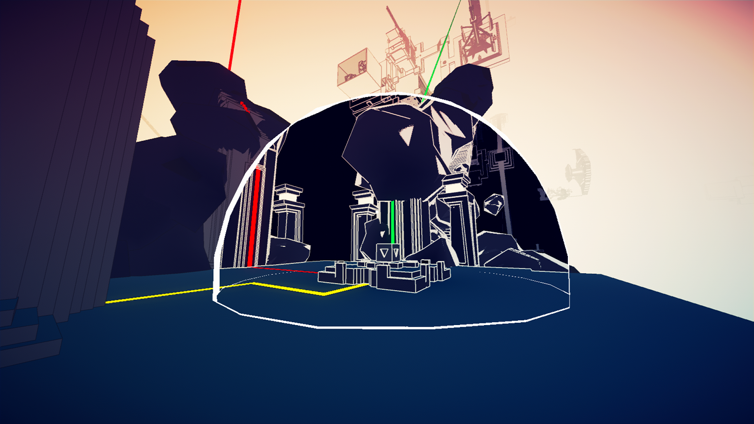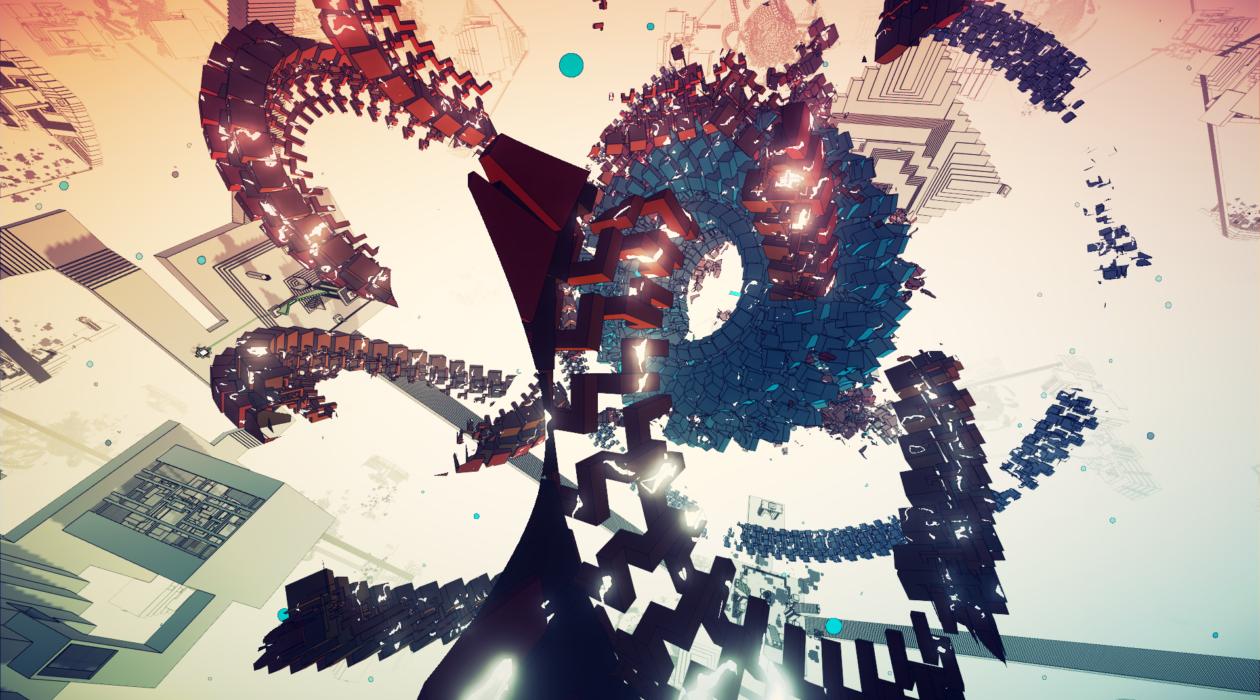“Are video games art?”. That’s a question that the gaming industry seems to ponder on an almost monthly basis. Someone releases a 2 hour video essay on how a game is – actually – a work of art and the whole debate explodes again. Manifold Garden, the debut game from artist William Chyr, poses a much more interesting question however – “Can art be a video game?”.

Manifold Garden is a game that takes the tenets and themes of much of M.C. Escher’s artwork – impossible geometry, complex architectural mazes, portals and perspective based reality – and converts them into a game world and the mechanics contained therein. If you’re not familiar with Escher’s work, imagine the impossibly upside down, gravity and logic defying part from the end of the Labyrinth movie. That whole scene is based on a M.C. Escher painting called Relativity.
The world of Manifold Garden is unlike anything else in the first person puzzle genre and it has a few unique rules. Firstly, the world loops on itself. Walk off a platform and you’ll fall past where you just stepped off given enough time falling. Secondly, you get to choose in which way you wish gravity to work. Press the right trigger while looking at a wall and you’ll walk onto the wall, making that the floor and the downward direction for gravity. If you imagine each wall of a room is the inside of a cube, a click of a button rotates that cube so that the intended wall is facing down. Each direction has its own colour coordination too, adding a gentle hue to the environments and is something that comes into play during puzzles.
Manifold Garden is a hands off experience. It doesn’t try to explain anything to you, allowing the player to explore and learn for themselves. There’s a gentle learning curve to this game which is welcome given how original some of its mechanics are. This curve is assisted by some very subtle but important nudges in the right direction. As an example, a small reticule on screen will change colour to the relevant gravity hue when it’s pointing at a wall and close enough to function.
There’s no explicit narrative either. There is however an implied objective which begins an hour into the game when you come into contact with a black, bubble like corruption that’s coating some sections of the game world. While it always backs away from your presence, this black substance hums and distorts your vision making it quite uncomfortable to be around. Removing it becomes a mission without the game ever having to force it on you.
To clear this black substance from the game, you’ll need to complete puzzles. Some of these are solitary while others play a part in a connected series of headscratchers that link to one another or build upon the last. Despite there being no way points or directions, Manifold Garden is a very easy game to read and identify what you’ve got to solve next.

For the most part, the puzzles in Manifold Garden have you moving boxes around to put on switches in order to open doors or activate objects. While that probably sounds boring, it’s anything but. You see, this game deftly incorporates M.C. Escher’s concepts into the mechanics themselves. The blocks you’ll be picking up and moving each have a colour. These blocks only come into play and become affected by gravity when you’ve activated the plane and colour they correspond to. For example, a red block will only allow you to pick it up when you’re standing on the surface that triggers a red hue to the world. The puzzles here are masterful in design. After a few simple puzzles to get the player used to the way this works, the complexity quickly ramps up. Putting down an orange block on the floor only to step onto the red wall/floor to use it as a step to reach higher up. Putting a red block on top of a yellow block so that when you flip the room and gravity, the yellow block simply stays where it is because the red block is now unaffected by gravity. These are the kinds of puzzles that require just a little forethought and out of the box thinking to solve but make you feel like a genius. They’re the best kind.
As you progress through Manifold Garden, new puzzle elements are introduced. Those coloured blocks start to get split in 2 with opposing colours on each side. These blocks are affected by gravity when either of the coloured planes are active. Later, beams of colour can paint a block to change what hue of gravity they’re attracted by. Water, sprouting from non-existent sources like in Escher’s Waterfall, becomes a mechanic. Those boxes? They can redirect the flow of a stream of water when placed in their path. You’ll need to gauge where to send the flow in order to power waterwheels. Water also acts like the boxes as in it only flows when a particular gravity hue is active. In any other, the water becomes a solid that can be used as a bridge. Later, there’s massive structures that move as you turn the world. Each new mechanic added brings more complexity but everything in Manifold Garden is so self-explanatory and well designed that with a little experimentation, each puzzle reveals its solution with time.
One of my favourite aspects of Manifold Garden is the efforts that have been made to ensure a puzzle can’t become unsolvable. There’s few things worse in a puzzle game than having to hit a restart button or pause the game and select “Try again?”. All of the pieces to solve a puzzle in this game are provided or can be reset in the game should you need too. Lose a block somewhere? There’s coloured trees dotted around that will respawn the desired block when picked from the tree like a piece of fruit.
Another unique aspect of Manifold Garden is the use of space. So often, first person puzzle games are closed in and almost claustrophobic. Puzzles rooms lead to other corridors and more rooms. That’s not the case here. Many of the games playable areas feel vast. That’s not because of the infinite looping world either. There are temple-like structures you explore which are massive without counting the looping.
It’s the way this game adapts some of the M.C. Escher staples which are most impressive though. For example, you’re standing at a T-junction. To the left side of you, there’s a stairway leading up. To the right, a staircase leading down. The trippy aspect? No matter which route you take, you’ll end up entering the next room on the exact same elevation. In another room, a puzzle sets a water source and a waterwheel separated by a massive chasm. After spending a few moments trying to figure out how I could possibly get the water across this gap, I saw a staircase on the left which brought me out on the other side of the chasm, like a Scooby Doo corridor chase. In another puzzle, the 2 doors leading into a room from either side send you into a different version of it but with the alternative reflected in a mirror along the wall. Some rooms act like a Tardis, appearing impossibly big on the other side of small doors. Manifold Garden is full of these little moments which are a constant reminder of the impossible being possible in this gorgeous world.
And this game world is gorgeous – but not traditionally so. Most of the world is bare and bereft of details which I would usually call out as an issue. That’s not the case here. Instead, Manifold Garden has a clean, brutalist “place of worship” vibe combined with organic architecture that’s entirely unique. The majority of the game is outlined and gently coloured. It’s a very satisfying aesthetic, like ASMR for your eyes.
Then there’s the ending. I don’t want to spoil it but the last 15 to 20 minutes feel like juxtaposition to the rest of the game and a phosphorus bright reward for your time with it. It’s simply breathtaking.
If there’s one element of Manifold Garden that I think could be improved upon, it’s the audio. The soundtrack itself is excellent, combining choral singing with atmospheric synth tracks to really set an ominous yet enticing tone. It’s quite jarring though when stepping through a door into a room for the music to change very suddenly and with a completely different volume. This happened often and it almost betrayed the transitions through magical doors and portals.

This game will challenge you, but it won’t overwhelm. It uses traditional puzzle mechanics that are easy to understand and blends them with the surreal and the new so that it feels totally fresh. It allows us to experience the tenets of an artist’s creations first hand and in living technicolour. An extensive photo mode means you can collect virtual keepsakes of this journey. If there ever was a game that proves “Games can be art”, it’s Manifold Garden – but more importantly it answers a new question. “Can art be a video game?”.
The answer? Yes. A brilliant one.
Manifold Garden is the best first person puzzle game since Portal 2. Unique spatial mechanics, a world that brings to life M.C. Escher’s work, a winsome art style and masterfully designed puzzles make this one of the easiest recommendations of 2020 so far.
9/10
Manifold Garden is available now on Xbox One (reviewed on an Xbox One S), PS4, PC via the EGS (coming to Steam soon), Nintendo Switch and iOS devices.
Developer: William Chyr Studio
Publisher: William Chyr Studio
Disclaimer: In order to complete this review we were provided with a promotional copy of the game. For our full review policy, please go here.
If you enjoyed this article or any more of our content, please consider our Patreon.
Make sure to follow Finger Guns on our social channels –Twitter, Facebook, Twitch, Spotify or Apple Podcasts – to keep up to date on our news, reviews and features.
